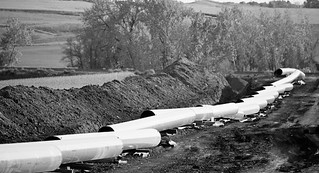
Photo Courtesy of Associated Press: Keystone pipeline being built in South Dakota
Nathan Crites-Herren
The Paw Print
Republicans and Democrats alike have sought to frame the Keystone oil pipeline has a massive job creation project which is being thwarted by “radical environmentalists.” This habit of politicians to polarize oil issues has environment vs. jobs means that the issue of jobs generally wins out over environmental issues. A recent Cornell University study claims that the Keystone pipeline could actually have a negative impact on the economies of the states it would pass through, bringing to light conveniently ignored issues by oil executives and politicians.
In the national debate, this either-or stance of environmental protection or job creation leaves out the fact that oil spills also kill jobs, consume resources, impact health and ultimately could lower the quality of life. The range of estimates of jobs varies widely. The pipelines operating company, TransCanada claims the pipeline will create 20,000 jobs. A State Department report estimates that only 20 permanent operating jobs would be created in the six states along the pipeline route. By comparison, those same states are home to robust agricultural, ranching and tourist industries that are dependent on water and vulnerable to environmental contamination. Throughout the six states in which the pipeline will pass agriculture employs 571,000 workers and tourism 780,000; respectively, the total revenue of those sectors is $76.6 billion and $67 billion.
The Keystone oil pipeline originating in the Athabasca tar oil sands in northeast Alberta, Canada and eventually going through Montana, South Dakota, Nebraska, Kansas, Oklahoma and Texas will be transporting tar sands oil, or better known in energy circles has diluted bitumen.
The Cornell University study claims that diluted bitumen is an irregular substance because it runs thick and thin, hot and cold. It’s basically sludge, not like regular crude oil so it behaves differently. Previous statistics about diluted bitumen clearly shows that the spill rate for diluted bitumen in the northern Midwest during 2007-2010 was three times the national average for conventional oil. This is in direct relation to the nature of tar oil, a heavy corrosive material which can create greater stress on pipelines.
The already existing Keystone I pipeline, which runs 2,100 miles from Alberta to Illinois, began operating in 2010; in the two years since, 35 spills have occurred. In their inaugural year, the spill rate was 100 times TransCanada’s projection. Analyzing spill data from the Keystone I pipeline, John Stansbury, a professor of civil engineering at the University of Nebraska was able to estimate that 91 spills would occur over the course of 50 years of Keystone XL’s operation — close to two spills each year. Stansbury says that in a worst case scenario the spill could contaminate up to 4.9 billion gallons of ground water in at any of the 36 pumping stations throughout the pipelines route.
The crucial threat that the pipeline poses is to the Ogallala Aquifer in Nebraska, which supplies up to 30 percent of the irrigation water in the U.S., has been the focal point of concern but the pipeline would also cross 1,747 bodies of water including the Yellowstone and Missouri Rivers.
If Keystone were to leak-or worse, rupture- the consequences would be disastrous. The Kalamazoo tar-sands oil spill in Michigan which occurred on July of 2010 carried bitumen 80 miles downstream and according to Michigan health officials more than half of the bitumen will indefinitely remain in the Kalamazoo.
Bitumen also contains benzene a known carcinogen, which has been found to cause over 300 cases of sever sickness in Michigan residents and death of livestock along the Rivers contaminated area. This was just a small rupture; if the massive Keystone pipes rupture the consequences will increase exponentially.
TransCanada insists that it will comply with all federal regulations, and construct and operate Keystone XL “to the highest industry standards.” But we still don’t know enough about diluted bitumen to transport is safely. As usual, oil companies are building the pipelines like they are meant for crude oil, not wanting to take the time to confirm that their oil transportation policies are safe and reliable.
This is yet another example of the peak oil predicament that the world superpowers are entering, and how the concerns for environmental vitality and sustainability are falling by the way side as everyone tries to ride the gas train till its wheels finally fall off.
What’s Been Said…